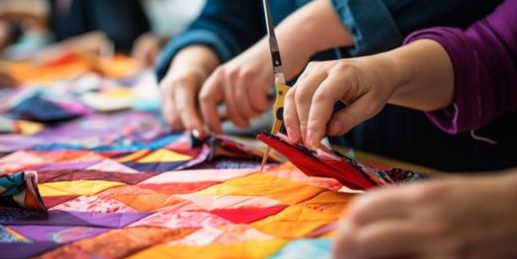Quilting is an age-old art that can be enjoyed by everyone. Whether you’re a beginner or an experienced quilter, teaming up with others can take your projects to the next level.
Working together can add creative energy and provide a great learning experience for all involved.

You’ll learn strategies for effective quilt-making teams, challenges of working in teams, and ways to foster communication and collaboration. Plus, you’ll find tips for making quilt-making projects fun and engaging.
Benefits of Teamwork in Quilt-Making
You can reap many benefits from working with a team when it comes to quilt-making. One of the most obvious is resource sharing.
Having multiple people working on the project means that each member can bring their own supplies and resources to the table, such as tools, fabric, and ideas. This allows for a greater variety of materials and design options for the quilt than any one person could come up with on their own.
Another advantage of teamwork is time management. With everyone contributing to the quilt, the task can be completed much faster than if a single person were to do it.
This is especially important if the quilt needs to be done with a specific deadline in mind. Working as a team gives everyone the chance to take on different aspects of the project, so it can be finished more quickly.
Finally, working together on a quilt-making project can be a great way to build relationships and strengthen team spirit.
Working in a group on a creative project can be a fun and rewarding experience that brings people together. As a team, members can share advice and tips with each other, provide support, and come up with new ideas.
Strategies for Effective Quilt-Making Teams
To ensure successful teamwork in quilt-making projects, you’ll need to implement certain strategies. These can be divided into three main categories: communication, collaboration, and organization.
- Communication:
- Openly discuss ideas and be willing to include diverse perspectives.
- Set expectations and provide feedback to ensure everyone is on the same page.
- Establish a clear chain of command.
- Collaboration:
- Brainstorm and come up with creative solutions.
- Share responsibilities and hold each other accountable.
- Ensure that each team member has the right resources.
- Organization:
- Set realistic deadlines and define goals.
- Utilize time management techniques to stay on track.
- Regularly assess progress and make adjustments.
Challenges of Working in Teams

Despite the potential benefits, working in teams can present certain challenges. Building trust between members is essential for successful collaboration, yet this can be hard to achieve when everyone has different personalities and opinions.
Additionally, communication can be difficult, as members must be able to openly and honestly share ideas in order to problem solve.
Division of labor can also be tricky, as it requires everyone to be on the same page in terms of expectations and contributions. This can be especially difficult when some members are more experienced than others, and there are unequal amounts of knowledge and skill levels among team members.
Time management is also a challenge, as members must be able to work together to meet deadlines and stay on task. This can be difficult to achieve when members have different work styles, different levels of commitment, and varying levels of motivation.
Finally, it can be hard to keep everyone on the same page when it comes to decision making. This can be especially true when there are debates over what direction the project should take, or when members disagree with each other’s ideas or opinions.
Teamwork is essential for successful quilt-making projects, but it’s important to recognize the potential challenges that come with working in teams. By tackling these challenges head on, quilt-making teams can successfully achieve their goals.
Ways to Foster Communication and Collaboration
In order to foster communication and collaboration, you must actively listen to each other and be open to different opinions.
To create a successful quilt-making team, there are several techniques you can use:
- Encourage Inspiration and Creativity:
- Allow time to explore different ideas and perspectives.
- Set aside time for brainstorming sessions.
- Allow for experimentation without fear of failure.
- Foster Trust:
- Create a safe space where everyone feels comfortable to share ideas.
- Respect each other’s opinions.
- Work together to achieve a common goal.
- Collaborate Effectively:
- Set achievable goals.
- Assign tasks based on individual strengths.
- Encourage feedback and constructive criticism.
By employing these techniques, team members can learn to trust each other, inspire each other’s creativity, and collaborate effectively to achieve a successful quilt-making project.
With an open mind and willingness to learn, teams can foster strong relationships and create beautiful quilts.
Tips for Making Quilt-Making Projects Fun and Engaging

Enjoy making quilt-making projects with your team by trying these fun and engaging tips! Sharing stories and creating goals are key to having a successful team project.
Sharing stories helps team members get to know each other, while creating goals will help keep the team on track and motivated. To make quilt-making projects fun and engaging, try some of the following ideas:
| Idea | Benefits |
|---|---|
| Brainstorm Together | Encourages creativity and collaboration |
| Designate Roles | Improves efficiency and organization |
| Take Breaks | Reduces stress and fatigue |
| Celebrate Progress | Rewards effort and encourages team spirit |
Brainstorming together can help the team come up with creative ideas and solutions. Designating roles can improve efficiency and organization, as each team member will have specific tasks to complete. Taking regular breaks can reduce stress and fatigue, while celebrating progress and achievements can reward effort and foster team spirit.
Ultimately, teamwork is essential for successful quilt-making projects. By incorporating these tips, teams can have fun and create beautiful pieces of art that everyone can be proud of.
Frequently Asked Questions [FAQs]
What Supplies Are Needed for Quilt-Making?
You’ll need fabric selection and thread colors for quilt-making. Pick materials that work together and make sure your thread colors match.
How Much Time Should Be Allotted for a Quilt-Making Project?
Time management is key when creating a quilt project. Allot enough time for creative collaboration and adjust if needed.
What Are the Best Methods for Organizing a Quilt-Making Team?
Organizing a team for any project requires good communication strategies and knowledge of group dynamics. Consider assigning roles, scheduling meetings, and discussing expectations to ensure successful teamwork.
How Many People Should Be in a Quilt-Making Team?
You should have a team of at least two people, so team dynamics and communication techniques can be utilized. This will help make the quilt-making project successful.
What Techniques Can Be Used to Make Quilt-Making Projects Less Intimidating?
You can make quilt-making projects less intimidating by dividing tasks and sharing ideas. Communicate and collaborate with your team to develop a plan that works best for everyone.
Conclusion
Teamwork in quilt-making projects can be a great way to create something beautiful and unique. By fostering communication and collaboration, you can ensure that everyone is on the same page and that the project runs smoothly.
Don’t forget to make it fun and engaging to keep everyone excited and motivated. With a bit of teamwork and creativity, you can create something truly amazing.




Leave a Reply